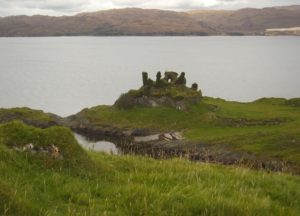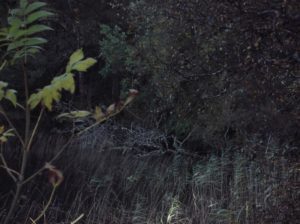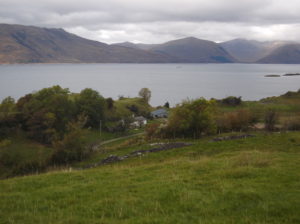 This is the view from a walk up to Dunollie Castle near Oban, looking at Kerrera, where we did not go, while we were on holiday last week. We did, however, go to Lismore, which you can just see in the distance, and saw this:
This is the view from a walk up to Dunollie Castle near Oban, looking at Kerrera, where we did not go, while we were on holiday last week. We did, however, go to Lismore, which you can just see in the distance, and saw this:

which, much as it looks like a strange rock formation, is actually Coeffin Castle. It was owned by the MacDougalls, who also own Dunollie, and a few more fortified buildings on this coast, which enabled them to control much of the country round during the Middle Ages.
Taking advantage of some beautiful weather, we also went to Knapdale to see the beavers, and though we did not catch a glimpse of them, we saw how active and ingenious they can be, with traces of their lodges on the loch,
 and some surprisingly big tree stumps which they had gnawed through. And to Kilmartin to look at the cairns and the henge at Temple Wood – and the beautiful herb garden at the museum, which must have been planted by someone very knowledgeable.
and some surprisingly big tree stumps which they had gnawed through. And to Kilmartin to look at the cairns and the henge at Temple Wood – and the beautiful herb garden at the museum, which must have been planted by someone very knowledgeable.
At all these places we were impressed by the visitor centres – well-designed and built, and though obviously making a profit and providing much needed employment opportunities, not rampantly commercial. The staff were well-informed and very friendly, and the inevitable cafes and gift shops used locally sourced food and gifts. Argyll lives gently and creatively with its history and its landscape, and I have come back inspired by this dialogue between past and present, between land and sea, and between the earth and the creatures on it.
By the time we got to the holiday, it was mostly about taking a break from a long period dealing with family illnesses and upheavals, but as well as being rested, I’ve come back with some thoughts about living and learning and writing in my own landscape. Some of the books I took with me have helped with this, and I’ll be writing a bit about that next week – but also, how can you not be inspired by landscapes like this.